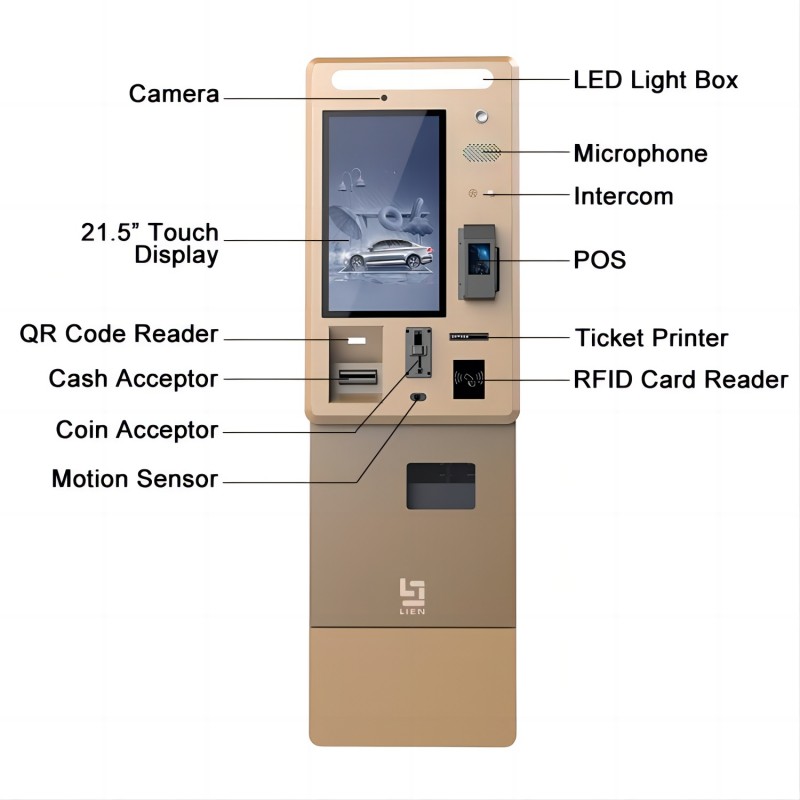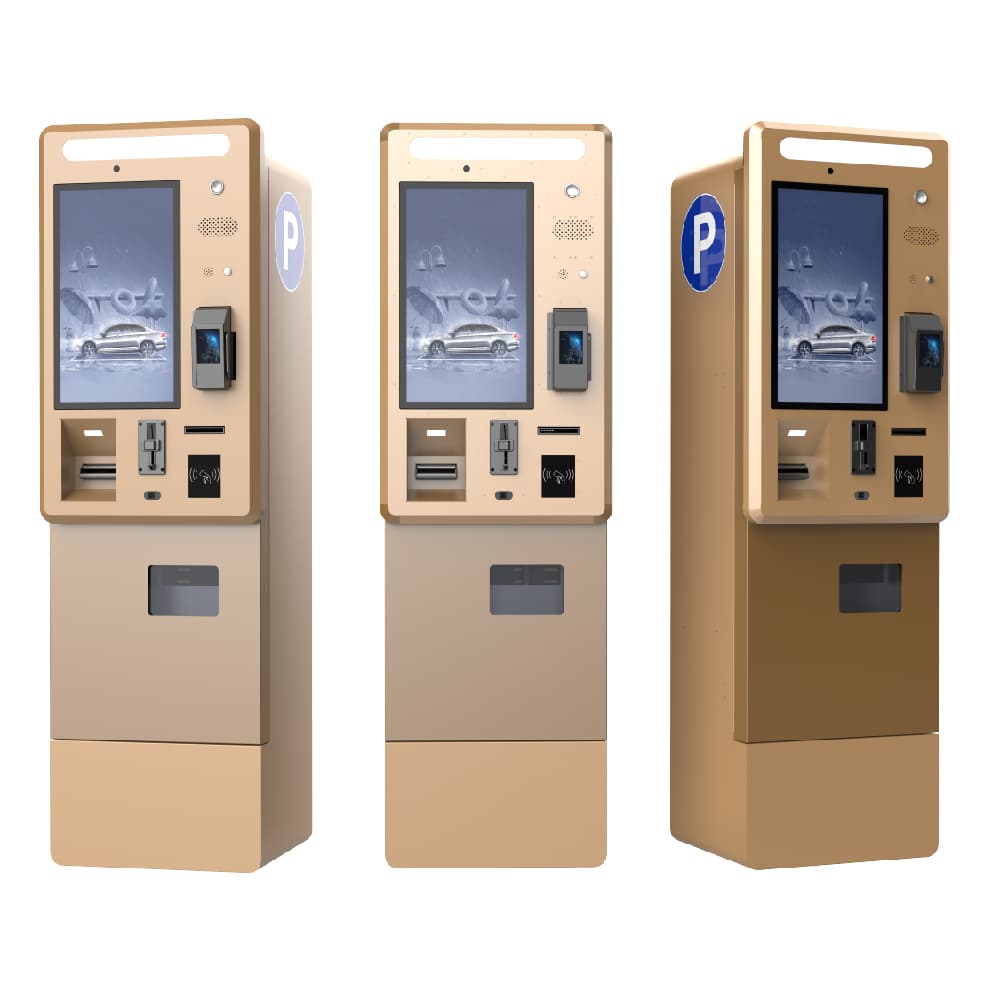Product Details
| Place of Origin: | Kiosk Manufacturer |
|---|---|
| Brand Name: | LKS Kiosk |
| Certification: | FCC, CE, ROHS |
| Model Number: | LKS8501A |
Payment & Shipping Terms
| Min Order: | 10 UNITS |
|---|---|
| Price: | $ |
| Packaging: | Strong Case |
| Delivery Time: | 5-6 weeks |
| Payment Terms: | TT |
| Supply Ability: | 5000 units per month |
Detailed Product Description
This parking payment kiosk is a cutting-edge, all-in-one payment solution from Lean Kiosk. Engineered for maximum efficiency, it offers a truly barrier-free payment experience. By seamlessly accepting every major payment method—from Coin, QR Code, NFC, Credit Card, POS, Barcode, and Debit Card to Cash Payment and Change—this advanced kiosk eliminates transaction friction. Its versatile and reliable system simplifies parking for drivers and streamlines operations for managers, ensuring a seamless flow of both traffic and revenue.
21.5 Inch Screen: | Capacitive Touchable Parking Payment Station | Function: | Parking Payment Station |
Type: | Free Standing Payment Kiosk | Payment: | Coin, QR Code, NFC, Credit Card, POS, Barcode, and Debit Card to Cash Payment and Change |
Usage: | Parking Garage | Receipt Printer: | 80 Mm Width |
Credit Card Reader: | Support | OS: | Android/windows |
Support: | Barcode Scanner |
 | Key Hardware of This Parking Payment KioskThe LKS Parking Payment Station support :
|
A modern parking kiosk is designed to accept virtually every type of payment, providing a seamless and barrier-free experience for every user. Here’s a detailed breakdown of each payment method and how to use it.
This traditional method ensures that customers without cards or mobile devices can still pay. The kiosk is equipped with specialized hardware to handle physical currency.
Select the cash payment option on the touchscreen.
Insert your banknotes into the bill acceptor and coins into the coin slot.
The kiosk will automatically calculate your payment and display the remaining balance.
The machine will dispense any change in coins and/or bills.
This is the most common form of electronic payment, processed through a secure Point-of-Sale (POS) terminal integrated into the kiosk.
Select the card payment option on the screen.
For Chip Cards: Insert your card into the chip reader slot and leave it there until the transaction is complete.
For Magnetic Stripe Cards: Swipe your card through the designated slot.
For Contactless Cards (NFC): Simply tap your card on the designated contactless payment symbol.
Follow any on-screen prompts for your PIN or signature.
NFC technology enables fast, contactless payments using a mobile device or a smartwatch. This method is also referred to as "tap-to-pay."
Choose the mobile payment option on the screen.
Open your mobile wallet app (e.g., Apple Pay, Google Pay) on your phone or smartwatch.
Hold your device near the NFC reader symbol on the kiosk.
The transaction will be completed in seconds, and you’ll receive a confirmation on your device and the kiosk screen.
This method is popular for mobile wallets and apps, especially in regions where platforms like Alipay and WeChat Pay are dominant.
Select the QR code payment option. The kiosk screen will display a unique QR code for your transaction.
Open your preferred mobile payment app on your phone.
Scan the QR code displayed on the kiosk screen with your phone’s camera.
Confirm the payment on your phone to complete the transaction.
Select the barcode payment option.
Open your payment app and generate a barcode on your phone's screen.
Hold your phone's screen up to the kiosk's barcode scanner. The kiosk will read the code to process the payment.

The parking kiosk's ability to accept a wide range of payment options—from cash and coins to QR codes and credit cards—is more than just a convenience; it's a powerful tool for boosting management efficiency.
This comprehensive payment flexibility directly maximizes revenue. By eliminating transaction friction, the kiosk ensures every customer, regardless of their preferred payment method, can complete their purchase. This means no lost sales and a significant increase in overall profitability. Furthermore, the kiosk collects valuable data on payment trends and usage patterns, providing managers with the insights needed to optimize pricing and operational strategies.
From an operational standpoint, the kiosk’s versatility leads to seamless traffic flow. The speed of digital payments and the choice of payment methods drastically reduce transaction times, which in turn minimizes vehicle queuing and prevents congestion at entry and exit points. By automating the entire payment process, the kiosk eliminates the need for manual cash handling and reduces the risk of human error, allowing staff to be reallocated to more critical tasks. This transforms a parking lot into a smarter, more efficient, and profitable system.
This multiple payments parking kiosk is an incredibly versatile solution, designed to provide efficient and convenient service in a wide range of high-traffic environments. These kiosks are commonly used in:
Public Parking Lots & Garages: Automating payment to reduce labor costs and traffic congestion.
Shopping Malls & Retail Centers: Enhancing the customer experience by providing fast, accessible payment options for shoppers.
Airports & Transportation Hubs: Offering a quick and multilingual solution for travelers who may not have local currency.
Hospitals & Medical Centers: Providing a stress-free payment method for patients and visitors.
Office Complexes & Event Venues: Managing high-volume traffic during peak hours, ensuring smooth entry and exit.
Here are 10 professional and practical FAQs addressing common payment-related issues with a parking payment kiosk, along with expert solutions.
The user should first try an alternative kiosk if one is available. If not, they should press the intercom button on the machine to speak with an attendant, who can assist remotely or provide instructions.
There can be a slight communication delay between the kiosk and the barrier. The user should wait a moment. If the barrier remains closed, they should use the intercom to contact an attendant for manual assistance.
In a "Pay-by-Plate" system, the license plate is the permit. The user's vehicle is already registered as paid in the central database. For a receipt, they can check if the kiosk offers an option for an e-receipt, or they can contact the parking office to request one.
This is often due to a full cash box or a jam. The user should try a different payment method such as a credit card or QR code. For operators, this indicates the need for a service check to empty the cash box or clear a jam.
This is usually a temporary authorization hold and not a duplicate charge. One of the transactions will typically be reversed by the bank within a few business days. If a double charge remains, the user should be directed to contact the parking management with their receipts for a formal refund.
The user should ensure their screen brightness is turned up to a maximum and that there is no glare from the sun. Holding the phone steady a few inches from the scanner helps. If the problem persists, the user can use a different payment method.
Our kiosks are designed with a reliable connection, but in an outage, they can be configured to process payments in a limited "offline mode." Once the network connection is restored, the kiosk will automatically upload the transaction data to the central system.
This is often a bank-side issue. The transaction will likely time out and reverse within minutes. The user should try a different card or a different payment method to avoid a duplicate charge.
The kiosk is designed to accept all major credit card brands. However, some international banks may have regional restrictions. In this case, the user should try to use a contactless payment method like a mobile wallet or an alternative card.
The user should immediately contact an attendant via the intercom. The kiosk's system can be remotely monitored and a physical service call will be dispatched to retrieve the card. The user should also be advised to contact their bank to report the issue.